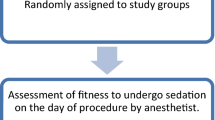Abstract
Aim: The aim of this study was to evaluate and describe the (dis)advantages of intravenous single drug anaesthesia (IVA) using the target-controlled infusion of propofol in order to validate a protocol. The treatments were performed in two secondary dental care clinics in Amsterdam. Methods: Retrospective study of the anaesthetic reports and medical history of 950 patients treated were screened for any irregularities and medical problems. Results: Most children treated were in the age group 2–5 years, time needed to wake up decreased significantly with age. Fourteen children dropped out of the planned IVA treatment because of medical reasons, 12 of whom were treated under general anaesthesia (GA). A further 26 were treated under GA because of convenience reasons. Total number of medical problems prior to treatment was 45 and mild complications were 42. Conclusions: There was a low morbidity in patients treated. The method seems to be successful in young children and creates an increase of treatment capacity in the field of special dental care. Preoperative screening is necessary, on paper and after consultation of a specialist. However blood test screening for allergies seem to be questionable. The treatment method is not possible without the presence of the anaesthesiologist and his team.
Similar content being viewed by others
References
Blayney MR, Ryan JD and Malins AF: Propofol target-controlled infusions for sedation-a safe technique for the non anaesthetist? Br Dent J. 2003 Apr 26; 194(8): 450–2; discussion 443.
Bricker S. Oasis or Mirage? The safety of outpatient dental anaesthesia in Hospital. Eur J Anaestesiol 2002 Feb; 119(2): 85–87
Brimacombe J, Berry A. The laryngeal mask airway for dental surgery — a review. Aust Dent J. 1995 Feb; 40(1): 10–4.
British Society of Paediatric Dentistry: A policy document on sedation for paediatric dentistry. Int. J. Paed. Dent. 6: 63–66, March, 1996.
Christen AG. Piagetian psychology: Some principles as helpful in treating the child dental patient. ASDC J Dent Child. 1977 Nov–Dec; 44 (6): 448–52.
EFAAD: Recommendations by the council of the European Federation for the Advancement of anaesthesia in dentistry concerning European standards for anaesthesia, analgesia and sedation in dentistry. Trier, Germany Sept. 1994.
Guidelines for the elective use of conscious sedation, deep sedation and general anaesthesia in Pediatric Dentistry: American Academy of Pediatric Dentistry
Hosey MT. Managing anxious children: the use of conscious sedation in paediatric dentistry. Int J Paediatr Dent. 2002 Jul; 12(4):359–72
Klingberg G, Berggren U. Dental problem behaviours in children of parents with severe dental fear. Swed Dent J. 1992; 16 (1–2): 27–32
Knape JT, Everdingen van JJ. Guideline for administration of sedatives and analgesics by physicians who are not anesthesiologists. Ned Tijdschr Geneeskd 1999; 143(21): 1098–1102
Landes DP. The provision of general anaesthesia in dental practice, an end which had to come. Br Dent J. 2002 Feb; 192(3): 129–131.
Needleman HL, Joshi A, Griffith G. Concious sedation of pediatric patients using chloral hydrate, hydroxine and nitrous oxide- a retrospective study of 382 sedations. Pediatr Dent. 1995 Nov–Dec; 17(7):424–31.
Oei-Lim VL, Kalkman CJ, Makkes PC, Ooms WG, Hoogstraten J. Computer controlled infusion of propofol for conscious sedation in dental treatment. Br Dent J 1997 Sep 27; 183 (6):204–8.
Parke TJ, Stevens JE, Rice AS et al. Metabolic acidosis and fatal myocardial failure after propofol infusion in children: five case reports. BMJ 1992 Sep 12; 305 (6854):613–6.
Tesniere A and Servin F: Intravenous techniques in ambulatory anesthesia. Anesthesiol Clin North America 2003 Jun; 21(2): 273–88.
Veerkamp JS, Porcelijn T, Gruythuysen RJ. Intravenous sedation for outpatient treatment of child dental patients: an exploratory study. ASDC J Dent Child. 1997 Jan–Feb; 64(1): 48–54
Veerkamp JSJ, Porcelijn T, Gruythuysen RJM. Dental treatment of children using propofol and a laryngeal mask. Eur J Paed Dent. 2002;3:14–22
Weaver JM. Propofol for intravenous conscious sedation-an oxymoron. Anesth Prog. 1999 Summer; 46(3): 89–90.
Weinstein P, Nathan JE. The challenge of fearful and phobic children. Dent Clin North Am 1998 Oct; 32(4):667–92
Wright FA, McMurray NE, Giebartowski J. Strategies used by dentists in Victoria, Australia, to manage children with anxiety or behavior problems. ASDC J Dent Child 1991 May–Jun; 58 (3): 223–8.
Author information
Authors and Affiliations
Corresponding author
Rights and permissions
About this article
Cite this article
Veerkamp, J.S.J., Porcelijn, T. & Wennink, J.M.B. An audit of single drug (propofol) dental general anaesthesia in children. Eur Arch Paediatr Dent 1, 100–105 (2006). https://doi.org/10.1007/BF03320823
Published:
Issue Date:
DOI: https://doi.org/10.1007/BF03320823




